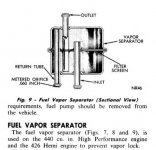falcon_master
Well-known member
Hello everyone. Hope everyone is doing well now summers around the corner. Me I’m excited every day I’m closer to getting my bird back in the road. But the temps are climbing. We’re getting closer to triple digit temps and sook will bee 100. A concern I have is vapor lock. Last thing I want is to stall out at a light or worse up a hill. My idea to solve this a cheap parts store external electric fuel pump underneath the fuel tank hooked up to relay. When fuel gets hot or when car sits flick on pump to re “prime” lines with fuel to avoid vapor lock and stalling. My question is it ok to have the fuel go through the stock pump. My only worry is if the diaphragm ruptures it’ll just pour fuel straight into the oil pan and I won’t notice until it’s done a lot of damage. What’s your all opinions? Also still debating between 144 or 200. And trying to tell of a 144 can even power AC.


